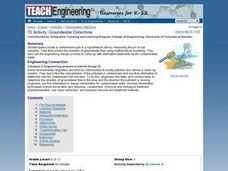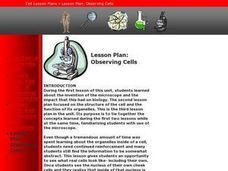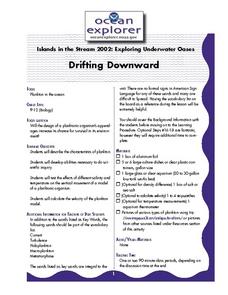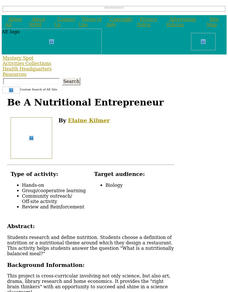Curated OER
How Do Organisms Vary?
Students study variation of organisms. They determine this variation arises from genetic and environmental causes.
Curated OER
GMOs: Should We Grow Them?
Students examine the ethics of biotechnology and genetically modifying various organisms. They complete various activities and labs on GMOs and then write a position paper regarding their individual opinions on the subject.
Curated OER
Groundwater Detectives
Students measure the pH of soil samples from a hypothetical site to locate a contaminant spill and will predict the direction of groundwater flow using mathematical modeling. They use the engineering design process to develop...
Curated OER
Genetics DNA Replication
Young scholars explore DNA replication. Beginning with a teacher led discussion, students examine inherited information, genes, and Deoxyribose Nucleic Acid (DNA). As the teacher models the structures of DNA, tells about the...
Curated OER
Terraqua Column
Sixth graders create a TerrAqua column. In this ecosystems lesson, 6th graders build a TerrAqua column to conduct investigations on how living things impact the ecosystem.
Curated OER
How Do Rice Farmers Grow Rice?
Second graders create rice bags using classroom objects. In this rice lesson, 2nd graders learn about how farmers grow their rice, and what hard work it is. Students learn about rice farmers all over the world and discuss the differences...
Curated OER
Frog and Toad
Second graders use a Venn Diagram to compare and contrast buttons after listening to the story, A Lost Button.
Curated OER
Disproving the Proof
Students investigate the progression of discoveries that have led to the genetics knowledge that scientists currently have. They determine how genetic experiments disproved previous theories on inheritance.
Curated OER
Deadly Disease among Us
Students recognize that infectious diseases are a continuing problem among all human populations. They define and give examples of emerging infectious diseases. Students define and give examples of re-emerging infectious diseases.
Curated OER
Darwin's Evolution
Students examine the impact of Charles Darwin and his theories on our life today. After watching a video, they discuss how he formulated his theories and how they have impacted the world both positively and negatively. To end the...
Curated OER
What's Eating Your Ship?
Students examine the processes that contribute to the deterioration of shipwrecked in shallow and deep water. In this research lesson students explore shipwrecks and how the deterioration process works. Students fill out the questions...
Curated OER
Building Bridges for Young Learners
Learners compare and contrast families around the world emphasizing the country of India. In this families lesson plan, students share and learn about roles in families, how we share characteristics, and how families in India are similar...
Curated OER
Individualism
Students demonstrate knowledge of the understanding of American individualism, specifically four areas: decision making, expressing opinions, competition, and obligation.
Curated OER
Nature and Fintess Trail
Students investigate how humans impact the environment and compile an organism database into an e-book field guide. They name muscle groups and develop specific exercises to strengthen these groups. Students utilize technology for data...
Curated OER
If It Smells Good, Is Edible, and Attracts Wildlife, Then It's a Practical Garden
Students explore landscape design. In this practical gardening lesson, students design landscape plans that call for shrubs, trees, and plants that can be used for aesthetics, cooking, and wildlife.
Curated OER
Saving Humpty Dumpty;Recycling, Environmental Science, Math, Ecology, Athletic Shoes
Learners describe how shoe design, manufacturing, retailing, consumer use, and disposal impact environments and societies. They discuss ways to reduce, reuse, or recycle resources in the life-cycle for a shoe product.
Curated OER
ARE WE IN THE MIDDLE OF A MASS EXTINCTION?
Students identify and interpret the following: What is mass extinction, and what are some theories for why it happens? How often do species become extinct? What is the normal rate of extinction? Why are some species endangered? What...
Curated OER
Drifting Downward
Learners study the effects of different salients and temperatures on vertical movement of an organism. For this experimental lesson students design different shapes of foil to simulate drifting planktonic organisms.
Curated OER
This Life Stinks
High schoolers study how organisms that live in cold seep communities get energy from methane. In this organism lesson students write a brief report and identify oxidation reduction reactions and explain if these are dependent of...
Curated OER
Cell Cycle Duration
Learners examine the cell cycle and how its duration can vary. In this cells lesson students complete a worksheet and answer questions.
Curated OER
Be A Nutritional Entrepreneur
Students research and define nutrition. They choose a definition of nutrition or a nutritional theme around which they design a restaurant. This activity helps students answer the question "What is a nutritionally balanced meal?"
Curated OER
Not In My Backyard: The Nature and Danger of Nuclear Radiation
Students evaluate the ways to control exposure to radiation and determine how to deal with the problem of nuclear waste in a rational rather than an emotional way.
Curated OER
Amazing Animals
Students, in beginning and advanced beginning ESL levels, use English in an animal lesson.

























